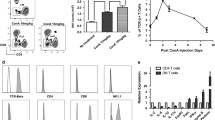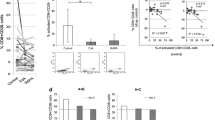Abstract
The majority of circulating CD4+ T cells express the Leu-8 peripheral lymph node homing receptor, and these cells have previously been shown to have suppressor-inducer and suppressor function. In the present study, it was found that CD4+, Leu-8+ T cells from patients with primary biliary cirrhosis (PBC) have a significantly (P<0.01) lower proliferative response when stimulated with phytohemagglutinin (PHA), concanavalin A (Con A), or pokeweed mitogen (PWM) compared to normal controls. The proliferative response of CD4+, Leu-8− T cells was similar in patients and controls. However, the proliferative responses of CD4+, Leu-8+ from patients with PBC was normal when cells were stimulated with PHA, Con A, anti-CD3 monoclonal antibody, or ionomycin in combination with phorbol myristate acetate (PMA). CD4+ T cells from patients with PBC mediated normal helper function for PWM-stimulated immunoglobulin synthesis at high T/B ratios and their regulatory function was similar to that of normal CD4+ T cells that had been irradiated to inactivate their suppressor activity. When CD4+ T cells from patients with PBC were precultured with the combination of Con A and PMA, they mediated potent inhibitory activity similar to that of normal CD4+ T cells. Thus, CD4+, Leu-8+ T cells from patients with PBC have a defect of proliferation and suppressor function that is reversed by coculture with PMA. This finding suggests that impairment of a PMA-inducible lymphocyte activation pathway contributes to abnormal lymphocyte function in PBC.
Similar content being viewed by others
References
Gershwin ME, Mackay IR: Primary biliary cirrhosis: Paradigm or paradox for autoimmunity. Gastroenterology 100:822–833, 1991
James SP: Immunology of hepatobiliary diseases.In Immunological Diseases. M Samter (ed). Boston, Little Brown, 1988, pp 1945–1993
Polson RJ, Portmann B, Neuberger J, Calne RY, Williams R: Evidence for disease recurrence after liver transplantation for primary biliary cirrhosis. Gastroenterology 97:715–725, 1989
Deeg HJ, Storb R: Graft-versus-host disease: Pathophysiological and clinical aspects. Annu Rev Med 35:11–24, 1984
Krams SM, Dorshkind K, Gershwin ME: Generation of biliary lesions following transfer of human lymphocytes into SCID mice. J Exp Med 170:1919–1930, 1989
James SP, Hoofnagle JH, Strober W, Jones EA: Primary biliary cirrhosis: A model autoimmune disease. Ann Intern Med 99:500–512, 1983
James SP, Elson CO, Jones EA, Strober W: Abnormal regulation of immunoglobulin synthesisin vitro in primary biliary cirrhosis. Gastroenterology 79:242–254, 1980
Rocklin RE, Maxwell NR, Thistle L, Kaplan MM:In vitro antimitochondrial antibody synthesis in patients with primary biliary cirrhosis. Clin Immunol Immunopathol 38:22–31, 1986
James SP, Jones EA, Hoofnagle JH, Strober W: Circulating activated B cells in primary biliary cirrhosis. J Clin Immunol 5:254–260, 1985
James SP, Elson CO, Waggoner JG, Jones EA, Strober A: Deficiency of the autologus mixed lymphocyte reaction in patients with primary biliary cirrhosis. J Clin Invest 66:1305–1310, 1980
Meuer SC, Moebius U, Manns MM, Dienes HP, Ramadori G, Hess G, Hercent T, Meyer zum Büschenfelde KH: Clonal analysis of human T lymphocytes infiltrating the liver in chronic active hepatitis B and primary biliary cirrhosis. Eur J Immunol 18:1447–1452, 1988
Kansas GS, Wood GS, Fishwild DM, Engleman EG: Functional characterization of human T lymphocyte subsets distinguished by monoclonal anti-Leu-8. J Immunol 134:2995–3002, 1985
Camerini D, James SP, Stamenkovic I, Seed B: Leu-8/TQ1 is the human equivalent of the Mel-14 lymph node homing receptor. Nature 342:78–82, 1989
Siegelman MH, Van de Rijn M, Weissman IL: Mouse lymph node homing receptor cDNA clone encodes a glycoprotein revealing tandem interaction domains. Science 243:1165–1172, 1989
Lasky LA, Singer MS, Yednock TA, Dowbenko D, Fennie C, Rodríguez H, Nguyen T, Satchel S, Rosen SD: Cloning of a lymphocyte homing receptor reveals a lectin domain. Cell 56:1045–1055, 1989
Bowen BR, Nguyen T, Lasky LA: Characterization of a human homologue of the murine peripheral lymph node homing receptor. J Cell Biol 109:421–427, 1989
Tedder TF, Isaacs CM, Ernst TJ, Demetri GD, Adler DA, Disteche CM: Isolation and chromosomal localization of cDNAs encoding a novel human lymphocyte cell surface molecule, LAM-1. J Exp Med 170:123–133, 1989
Bevilacqua MP, Stengelin S, Gimbrone MA, Seed B: Endothelial leukocyte adhesion molecule 1: An inducible receptor for neutrophils related to complement regulatory proteins and lectins. Science 243:1160–1164, 1989
Johnston GI, Cook RG, McEver RP: Cloning of GMP-140, a granule membrane protein of platelets and endothelium: Sequence similarity to proteins involved in cell adhesion and inflammation. Cell 56:1033–1044, 1989
Stoolman LM: Adhesion molecules controlling lymphocyte migration. Cell 56:907–910, 1989
Berg EL, Goldstein LA, Jutila MA, Nakache M, Picker LJ, Streeter PR, Wu NW, Zhou D, Butcher EC: Homing receptors and vascular addressins: Cell adhesion molecules that direct lymphocyte traffic. Immunol Rev 108:5–18, 1989
Kishimoto TK, Jutila MA, Berg EL, Butcher EC: Neutrophil Mac-1 and MEL-14 adhesion proteins inversely regulated by chemotactic factors. Science 245:1238–1241, 1989
Watson SR, Imai Y, Fennie C, Geoffroy JS, Rosen SD, Lasky LA: A homing receptor-IgG chimera as a probe for adhesive ligands of lymph node high endothelial venules. J Cell Biol 110:2221–2229, 1990
Watson SR, Fennie C, Lasky LA: Neutrophil influx into an inflammatory site inhibited by a soluble homing receptor-IgG chimaera. Nature 349:164–167, 1991
Kanof ME, Strober W, James SP: Induction of CD4 suppressor T cells with anti-Leu-8 antibody. J Immunol 139:49–54, 1987
Damle NK, Mohagheghpour N, Engleman EG: Soluble antigen-primed inducer T cells activate antigen-specific suppressor T cells in the absence of antigen-pulsed accessory cells: Phenotypic definition of suppressor-inducer and suppressor-effector cells. J Immunol 132:644–650, 1984
Murakawa Y, Strober W, James SP: Monoclonal antibody against the human peripheral lymph node homing receptor homologue (Leu 8) inhibits B cell differentiation but not B cell proliferation. J Immunol 146:40–46, 1991
Suou T, Civeira MP, Kanof ME, Moreno-Otero R, Jones EA, James SP: Defective immunoregulation in primary biliary cirrhosis: CD4+, Leu-8+ T cells have abnormal activation and suppressor functionin vitro. Hepatology 10:408–413, 1989
Truneh A, Albert F, Golstein P, Schmitt-Verhulst A-M: Early steps of lymphocyte activation bypassed by synergy between calcium ionophores and phorbol ester. Nature 313:318–320, 1985
Castagna M, Takai Y, Kaibuchi K, Sano K, Kikkawa U, Nishizuka Y: Direct activation of calcium-activated, phospholipid-dependent protein kinase by tumor-promoting phorbol esters. J Biol Chem 257:7847–7851, 1982
Kikkawa U, Kishimoto A, Nishizuka Y: The protein kinase C family: Heterogeneity and its implications. Annu Rev Biochem 58:31–44, 1989
Scheuer PJ: Liver Biopsy Interpretation, 3rd. ed. London, Bailliere Tindall, 1980, pp 36–59
Valge VE, Wong JGP, Datlof BM, Sinskey AJ, Rao A: Protein kinase C is required for responses to T cell receptor ligands but not to interleukin-2 in T cells. Cell 55:101–112, 1988
Weiss A, Imboden JB: Cell surface molecules and early events in human T lymphocyte activation. Adv Immunol 41:1–38, 1987
Lenardo MJ, Baltimore D: NF-κB: A pleiotropic mediator of inducible and tissue specific gene control. Cell 58:227–229, 1989
Ullman KS, Northrop JP, Verweij CL, Crabtree GR: Transmission of signals from the T lymphocyte antigen receptor to the genes responsible for cell proliferation and immune function: The missing link. Annu Rev Immunol 8:421–452, 1990
Leca G, Boumsell L, Fabbi M, Reinherz EL, Kanellopoulos JM: The sheep erythrocyte receptor and both alpha and beta chains of the human T lymphpcyte receptor bind the mitogenic lectin (phytohaemagglutinin) fromPhaseolus vulgaris. Scand J Immunol 23:535–544, 1986
Lööf L, Hakansson L, Nyberg A, Venge P: Defective C3b receptor-mediated phagocytosis of neutrophils in patients with primary biliary cirrhosis. Scand J Gastroenterol 22:1169–1174, 1987
Olmos JM, García JD, Jiménez A, de Castro S: Impaired monocyte function in primary biliary cirrhosis. Allergol Immunopathol (Madr) 16:353–358, 1988
DasGupta JD, Egea E, Relias V, Iglesias A, Gladstone P, Yunis EJ: Involvement of major histocompatibility complex class I antigens in T-cell activation. Eur J Immunol 20:1553–1561, 1990
June CH, Ledbetter JA, Linsley PS, thompson CD: Role of the CD28 receptor in T-cell activation. Immunol Today 11:211–216, 1990
Huet S, Groux H, Caillou B, Valentin H, Prieur AM, Bernard A: CD44 contributes to T cell activation. J Immunol 143:798–801, 1989
Janeway CA: The T cell receptor as a multicomponent signalling machine: CD4/CD8 coreceptors and CD45 in T cell activation. Annu Rev Immunol 10:645–674, 1992
Testi R, Phillips JH, Lanier LL: T cell activation via Leu-23 (CD69). J Immunol 143:1123–1128, 1989
Colucci G, Schaffner F, Paronetto F:In situ characterization of the cell-surface antigens of the mononuclear cell infiltrate and bile duct epithelium in primary biliary cirrhosis. Clin Immunol Immunopathol 41:35–42, 1986
Shimizu M, Yuh K, Aoyama S, Ichihara I, Watanabe H, Shijo H, Okumura M: Immunohistochemical characterization of inflammatory infiltrates at the site of bile duct injury in primary biliary cirrhosis. Liver 6:1–6, 1986
Author information
Authors and Affiliations
Rights and permissions
About this article
Cite this article
Moreno-Otero, R., Murakawa, Y., Kanof, M.E. et al. Defective proliferation and regulatory function of CD4+ T cells bearing Leu-8 homing receptor in primary biliary cirrhosis. Digest Dis Sci 39, 1329–1336 (1994). https://doi.org/10.1007/BF02093801
Received:
Accepted:
Issue Date:
DOI: https://doi.org/10.1007/BF02093801




